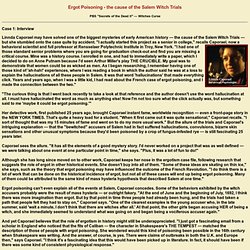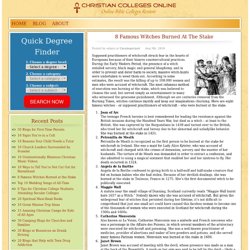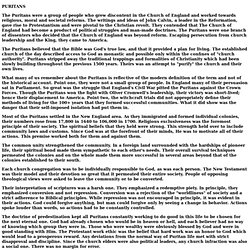

Abigail Williams - Salem Witch Trials. Known for: accuser in the Salem witch trials of 1692; one of the first two girls "afflicted" Occupation: servant?

Age at time of Salem witch trials: 11 or 12 Dates: about 1680 - ? Family, Background: Abigail Williams, who lived in the home of the Rev. Samuel Parris, has often been called a "niece" of Rev. Parris. Called "kinfolk" in some early sources. Abigail Williams and the Salem Witch Trials Abigail Williams and Elizabeth (Betty) Parris, daughter of Rev. Abigail and Betty were joined by Ann Putnam Jr. in their afflictions and, then, in accusations against individuals identified as causing the afflictions. Abigail's and Betty's accusations resulted in the arrest on February 29 of Tituba, Sarah Good and Sarah Osborne. On March 29, Abigail Williams and Mercy Lewis accused Elizabeth Proctor of afflicting them through her specter; Abigail claimed to see John Proctor's spectre as well.
Ergot Poisoning (LSD) - the cause of the Salem Witch Trials - PBS Secrets of the Dead. Case 1: Interview Linnda Caporael may have solved one of the biggest mysteries of early American history — the cause of the Salem Witch Trials — but she stumbled onto the case quite by accident.

"I actually started this project as a senior in college," recalls Caporael, now a behavioral scientist and full professor at Rensselaer Polytechnic Institute in Troy, New York. "I had one of those standard senior problems where you are going for graduation check-out and find you are missing a critical course. Mine was a history course. "The curious thing is that I went back recently to take a look at that reference and the author doesn't use the word hallucination at all. Her detective work, first published 25 years ago, brought Caporael instant fame, worldwide recognition — even a front-page story in the NEW YORK TIMES. Caporael sees the allure. An account of the Salem witchcraft investigations, trials, and aftermath.
8 Famous Witches Burned at the Stake. Posted by admin in Uncategorized Aug 9th, 2010 Supposed practitioners of witchcraft struck fear in the hearts of Europeans because of their bizarre countercultural practices.

During the Early Modern Period, the presence of a witch entailed sorcery, black magic and general blasphemy, and in order to prevent and deter harm to society, massive witch-hunts were undertaken to weed them out. According to some estimates, the result was the killing of up to 100,000 women and men who were accused of witchcraft. The most infamous method of execution was burning at the stake, which was believed to cleanse the soul, but served simply as entertainment to many who witnessed the gruesome punishment. Although we are centuries removed from the Burning Times, witches continue mystify and keep our imaginations churning. Delicious Digg This Reddit Stumble This Did you enjoy this article? Salem Witch Trials. Arthur Miller's The Crucible: Fact & Fiction.
By Margo Burns Revised: 10/30/15 I've been working with the materials of the Salem Witch Trials of 1692 for so long as an academic historian, it's not surprising when people ask me if I've seen the play or film The Crucible, and what I think of it.

Miller created works of art, inspired by actual events, for his own artistic/political intentions. First produced on Broadway on January 22, 1953, the play was partly a response to the panic caused by irrational fear of Communism during the Cold War which resulted in the hearings by the House Committee on Unamerican Activities.1 In Miller's play and screenplay, however, it is a lovelorn teenager, spurned by the married man she loves, who fans a whole community into a blood-lust frenzy in revenge. This is simply not history. Whether this activity is worthwhile or not really depends on what one wants from the play or movie. This play is not history in the sense in which the word is used by the academic historian. Lastly, Rev. Notes 1. 2. 3. The Salem Witch Trials, 1692. The Salem Witch Trials, 1692 The seeds of the hysteria that afflicted Salem Village, Massachusetts were sown in January 1692 when a group of young girls began to display bizarre behavior.

The tight-knit community was at a loss to explain the convulsive seizures, blasphemous screaming, and trance-like states that afflicted the youngsters. Puritans. The Puritans were a group of people who grew discontent in the Church of England and worked towards religious, moral and societal reforms.

The writings and ideas of John Calvin, a leader in the Reformation, gave rise to Protestantism and were pivotal to the Christian revolt. They contended that The Church of England had become a product of political struggles and man-made doctrines. The Puritans were one branch of dissenters who decided that the Church of England was beyond reform. Escaping persecution from church leadership and the King, they came to America.